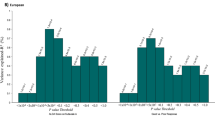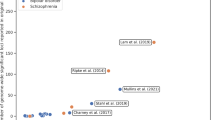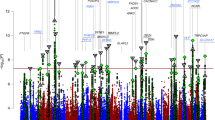Abstract
Despite compelling evidence for a major genetic contribution to risk of bipolar mood disorder, conclusive evidence implicating specific genes or pathophysiological systems has proved elusive. In part this is likely to be related to the unknown validity of current phenotype definitions and consequent aetiological heterogeneity of samples. In the recent Wellcome Trust Case Control Consortium genome-wide association analysis of bipolar disorder (1868 cases, 2938 controls) one of the most strongly associated polymorphisms lay within the gene encoding the GABAA receptor β1 subunit, GABRB1. Aiming to increase biological homogeneity, we sought the diagnostic subset that showed the strongest signal at this polymorphism and used this to test for independent evidence of association with other members of the GABAA receptor gene family. The index signal was significantly enriched in the 279 cases meeting Research Diagnostic Criteria for schizoaffective disorder, bipolar type (P=3.8 × 10−6). Independently, these cases showed strong evidence that variation in GABAA receptor genes influences risk for this phenotype (independent system-wide P=6.6 × 10−5) with association signals also at GABRA4, GABRB3, GABRA5 and GABRR1. Our findings have the potential to inform understanding of presentation, pathogenesis and nosology of bipolar disorders. Our method of phenotype refinement may be useful in studies of other complex psychiatric and non-psychiatric disorders.
This is a preview of subscription content, access via your institution
Access options
Subscribe to this journal
Receive 12 print issues and online access
$259.00 per year
only $21.58 per issue
Buy this article
- Purchase on Springer Link
- Instant access to full article PDF
Prices may be subject to local taxes which are calculated during checkout
Similar content being viewed by others
References
Müller-Oerlinghausen B, Berghöfer A, Bauer M . Bipolar disorder. Lancet 2002; 359: 241–247.
Craddock N, Jones I . Genetics of bipolar disorder. J Med Genet 1999; 36: 585–594.
McGuffin P, Rijsdijk F, Andrew M, Sham P, Katz R, Cardno A . The heritability of bipolar affective disorder and the genetic relationship to unipolar depression. Arch Gen Psychiatry 2003; 60: 497–502.
Gershon ES, Liu C, Badner JA . Genome-wide association in bipolar. Mol Psychiatry 2008; 13: 1–2.
Hayden EP, Nurnberger Jr JI . Molecular genetics of bipolar disorder. Genes Brain Behav 2006; 5: 85–95.
Potash JB . Carving chaos: genetics and the classification of mood and psychotic syndromes. Harv Rev Psychiatry 2006; 14: 47–63.
Maier W, Höfgen B, Zobel A, Rietschel M . Models of schizophrenia and bipolar disorder: overlapping inheritance or discrete genotypes? Eur Arch Psychiatry Clin Neurosci 2005; 255: 159–166.
Berrettini W . Bipolar disorder and schizophrenia: not so distant relatives? World Psychiatry 2003; 2: 68–72.
Craddock N, O’Donovan MC, Owen MJ . The genetics of schizophrenia and bipolar disorder: dissecting psychosis. J Med Genet 2005; 42: 193–204.
Potash JB, Zandi PP, Willour VL, Lan TH, Huo Y, Avramopoulos D et al. Suggestive linkage to chromosomal regions 13q31 and 22q12 in families with psychotic bipolar disorder. Am J Psychiatry 2003; 160: 680–686.
Park N, Juo SH, Cheng R, Liu J, Loth JE, Lilliston B et al. Linkage analysis of psychosis in bipolar pedigrees suggests novel putative loci for bipolar disorder and shared susceptibility with schizophrenia. Mol Psychiatry 2004; 9: 1091–1099.
Maziade M, Roy MA, Chagnon YC, Cliche D, Fournier JP, Montgrain N et al. Shared and specific susceptibility loci for schizophrenia and bipolar disorder: a dense genome scan in Eastern Quebec families. Mol Psychiatry 2005; 10: 486–499.
Craddock N, Owen MJ . Rethinking psychosis: the disadvantages of a dichotomous classification now outweigh the advantages. World Psychiatry 2007; 6: 20–27.
Wellcome Trust Case Control Consortium. Genome-wide association study of 14 000 cases of seven common diseases and 3000 shared controls. Nature 2007; 447: 661–678.
Brambilla P, Perez J, Barale F, Schettini G, Soares JC . GABAergic dysfunction in mood disorders. Mol Psychiatry 2003; 8: 721–737, 715.
Coyle JT . The GABA-glutamate connection in schizophrenia: which is the proximate cause? Biochem Pharmacol 2004; 68: 1507–1514.
Kalueff AV, Nutt DJ . Role of GABA in anxiety and depression. Depress Anxiety 2007; 24: 495–517.
Krystal JH, Staley J, Mason G, Petrakis IL, Kaufman J, Harris RA et al. Gamma-aminobutyric acid type A receptors and alcoholism: intoxication, dependence, vulnerability, and treatment. Arch Gen Psychiatry 2006; 63: 957–968.
Moss SJ, Smart TG . Constructing inhibitory synapses. Nat Rev Neurosci 2001; 2: 240–250.
Möhler H . GABA(A) receptor diversity and pharmacology. Cell Tissue Res 2006; 326: 505–516.
Rudolph U, Crestani F, Möhler H . GABA(A) receptor subtypes: dissecting their pharmacological functions. Trends Pharmacol Sci 2001; 22: 188–194.
Simon J, Wakimoto H, Fujita N, Lalande M, Barnard EA . Analysis of the set of GABA(A) receptor genes in the human genome. J Biol Chem 2004; 279: 41422–41435.
Spitzer RL, Endicott J, Robins E . Research diagnostic criteria: rationale and reliability. Arch Gen Psychiatry 1978; 35: 773–782.
Wing JK, Babor T, Brugha T, Burke J, Cooper JE, Giel R et al. SCAN: Schedules for Clinical Assessment in Neuropsychiatry. Arch Gen Psychiatry 1990; 47: 589–593.
McGuffin P, Farmer A, Harvey I . A polydiagnostic application of operational criteria in studies of psychotic illness. Development and reliability of the OPCRIT system. Arch Gen Psychiatry 1991; 48: 764–770.
Green EK, Raybould R, Macgregor S, Hyde S, Young AH, O’Donovan MC et al. Genetic variation of brain-derived neurotrophic factor (BDNF) in bipolar disorder: case-control study of over 3000 individuals from the UK. Br J Psychiatry 2006; 188: 21–25.
Green EK, Raybould R, Macgregor S, Gordon-Smith K, Heron J, Hyde S et al. Operation of the schizophrenia susceptibility gene, neuregulin 1, across traditional diagnostic boundaries to increase risk for bipolar disorder. Arch Gen Psychiatry 2005; 62: 642–648.
American Psychiatric Association. Diagnostic and Statistical Manual of Mental Disorders, 4th edn. American Psychiatric Press: Washington, DC, 1994.
Craddock N, Jones I, Kirov G, Jones L . The Bipolar Affective Disorder Dimension Scale (BADDS)—a dimensional scale for rating lifetime psychopathology in bipolar spectrum disorders. BMC Psychiatry 2004; 5: 4:19.
Hoh J, Wille A, Ott J . Trimming, weighting, and grouping SNPs in human case-control association studies. Genome Res 2001; 11: 2115–2119.
Barrett JC, Fry B, Maller J, Daly MJ . Haploview: analysis and visualization of LD and haplotype maps. Bioinformatics 2005; 21: 263–265.
Purcell S, Neale B, Todd-Brown K, Thomas L, Ferreira MA, Bender D et al. PLINK: a tool set for whole-genome association and population-based linkage analyses. Am J Hum Genet 2007; 81: 559–575.
Khoury MJ, Beaty TH, Cohen BH (eds). Fundamentals of Genetic Epidemiology 1993; Oxford University Press: Oxford, 381p.
Lattin JM, Carroll JD, Green PE . Analyzing Multivariate Data. Thomson Brooks/Cole: Pacific Grove, CA, 2003.
Hattori E, Liu C, Zhu H, Gershon ES . Genetic tests of biologic systems in affective disorders. Mol Psychiatry 2005; 10: 719–740.
Hamshere ML, Bennett P, Williams N, Segurado R, Cardno A, Norton N et al. Genomewide linkage scan in schizoaffective disorder: significant evidence for linkage at 1q42 close to DISC1, and suggestive evidence at 22q11 and 19p13. Arch Gen Psychiatry 2005; 62: 1081–1088.
Craddock N, Owen MJ . The beginning of the end for the Kraepelinian dichotomy. Br J Psychiatry 2005; 186: 364–366.
Merikangas KR, Ames M, Cui L, Stang PE, Ustun TB, Von Korff M et al. The impact of comorbidity of mental and physical conditions on role disability in the US adult household population. Arch Gen Psychiatry 2007; 64: 1180–1188.
Craddock N, Owen MJ, O’Donovan MC . The catechol-O-methyl transferase (COMT) gene as a candidate for psychiatric phenotypes: evidence and lessons. Mol Psychiatry 2006; 11: 446–458.
Acknowledgements
We are indebted to all individuals who have participated in our research. Funding for recruitment and phenotype assessment has been provided by the Wellcome Trust and the Medical Research Council. We are grateful to Dr Shaun Purcell for advice and support in the use of the PLINK analysis software. The genotype analyses were funded by the Wellcome Trust and undertaken within the context of the Wellcome Trust Case Control Consortium (WTCCC). The members of the WTCCC are listed in online supplementary information.
Author information
Authors and Affiliations
Consortia
Corresponding author
Additional information
Supplementary Information accompanies the paper on the Molecular Psychiatry website (http://www.nature.com/mp)
Supplementary information
Rights and permissions
About this article
Cite this article
Craddock, N., Jones, L., Jones, I. et al. Strong genetic evidence for a selective influence of GABAA receptors on a component of the bipolar disorder phenotype. Mol Psychiatry 15, 146–153 (2010). https://doi.org/10.1038/mp.2008.66
Received:
Revised:
Accepted:
Published:
Issue Date:
DOI: https://doi.org/10.1038/mp.2008.66
Keywords
This article is cited by
-
Structural basis of GABARAP-mediated GABAA receptor trafficking and functions on GABAergic synaptic transmission
Nature Communications (2021)
-
Gene expression links functional networks across cortex and striatum
Nature Communications (2018)
-
Early developmental bisphenol-A exposure sex-independently impairs spatial memory by remodeling hippocampal dendritic architecture and synaptic transmission in rats
Scientific Reports (2016)
-
Genomic insights into the overlap between psychiatric disorders: implications for research and clinical practice
Genome Medicine (2014)
-
Neurodevelopmental disorders among individuals with duplication of 4p13 to 4p12 containing a GABAA receptor subunit gene cluster
European Journal of Human Genetics (2014)



